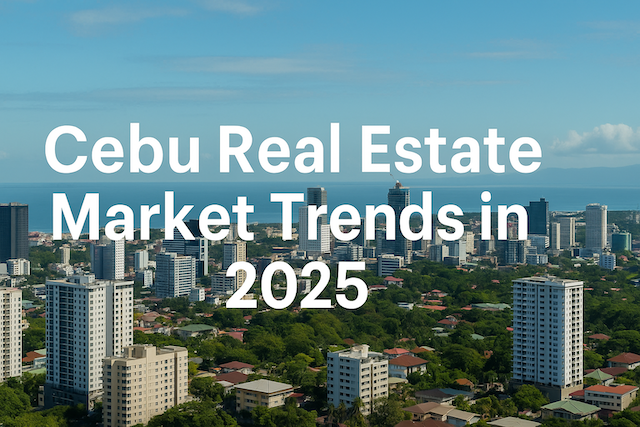Cebu Real Estate Market Trends in 2025

Contents
- Cebu Real Estate Market Trends in 2025: What Buyers, Investors, and Renters Need to Know
- 1. Introduction: Why Cebu Still Matters in 2025
- 2. Post-Pandemic Recovery: What Changed Since 2020
- 3. Key Areas Experiencing Growth
- 4. Price Trends in 2025: Residential Property
- 5. Rental Market in Cebu: 2025 Snapshot
- 6. Hot Property Types in 2025
- 7. Key Developers to Watch in Cebu
- 8. Infrastructure Catalysts Boosting Demand
- 9. Government Policies and Foreign Investment
- 10. Cebu’s Competitive Advantage in 2025
- 11. Market Risks and Challenges
- 12. 2025 Buyer and Renter Personas
- 13. Investment Tips for 2025
- 14. Market Forecast: 2025–2026
- Conclusion: Cebu Real Estate in 2025
- Frequently Asked Questions (FAQ): Cebu Real Estate Market Trends in 2025
- 1. Is Cebu still a good place to invest in property in 2025?
- 2. What are the best areas to buy property in Cebu this year?
- 3. Are condo prices rising in Cebu?
- 4. Is it better to buy pre-selling or RFO property?
- 5. What’s the average rental yield for condos in Cebu?
- 6. Can foreigners buy property in Cebu?
- 7. What’s the status of infrastructure development in Cebu?
- 8. Are beachfront properties still available in Mactan?
- 9. What property types are popular in Cebu this year?
- 10. Are rental prices in Cebu increasing?
- 11. Is it easy to rent out property in Cebu?
- 12. What risks should buyers consider in 2025?
- 13. Are townhouses a good investment?
- 14. How can I finance a property purchase in Cebu?
- 15. What legal documents are required when buying property?
- 16. Will Cebu’s market remain strong through 2026?
Cebu Real Estate Market Trends in 2025: What Buyers, Investors, and Renters Need to Know
1. Introduction: Why Cebu Still Matters in 2025
The Cebu real estate market continues to draw significant interest from both local and foreign investors. As the Philippines’ second-largest metropolitan area, Cebu offers a unique mix of business opportunities, tourism, and urban convenience. In 2025, the post-pandemic recovery is well underway, infrastructure is booming, and the demand for residential and commercial space is steadily climbing.
From affordable studio units to luxury high-rises and beachfront villas, Cebu’s real estate landscape is more dynamic than ever. This guide explores the most important market trends shaping property investment and development in the region.
2. Post-Pandemic Recovery: What Changed Since 2020
The real estate sector in Cebu saw a dip in new launches and transactions during the height of COVID-19, but 2023–2024 showed strong recovery. In 2025:
-
Sales volumes have rebounded to pre-pandemic levels, especially in pre-selling condo markets.
-
RFO (Ready-for-Occupancy) units in strategic locations like IT Park and SRP are nearly sold out.
-
Foreign investors have returned, thanks to relaxed travel and business regulations.
-
Developers are targeting both end-users and hybrid investors seeking rental yields.
3. Key Areas Experiencing Growth
Cebu IT Park and Lahug
-
Remains the top choice for professionals and digital nomads.
-
Studio and 1BR units by developers like Avida, Cebu Landmasters, and Filinvest are high in demand.
-
Rental yields remain stable (5–7%) due to consistent occupancy.
South Road Properties (SRP)
-
Major transformation zone in 2025 with projects like NuStar Resort & Casino and SM Seaside Complex expansion.
-
Land values in SRP have increased by over 15% YoY.
-
Ideal for mixed-use development and long-term investors.
Mandaue and Consolacion
-
Fastest-growing zones for affordable and mid-range housing.
-
Townhouses and compact subdivisions dominate launches.
-
Increased connectivity from the Metro Cebu Expressway fuels interest.
Liloan and Compostela
-
Emerging areas with lower land costs.
-
Perfect for house-and-lot developments, retirement homes, and low-rise condos.
4. Price Trends in 2025: Residential Property
| Property Type | Location | Price/Sqm (PHP) | YoY % Growth |
|---|---|---|---|
| Studio Condo (Pre-Selling) | IT Park | ₱150K–₱180K | +10% |
| Studio Condo (RFO) | Lahug | ₱130K–₱150K | +7% |
| House and Lot | Mandaue | ₱60K–₱80K | +12% |
| Townhouses | Talisay | ₱40K–₱55K | +9% |
| Beachfront Villas | Lapu-Lapu | ₱180K–₱250K | +6% |
Condo prices have surged in central areas, while more affordable options exist in suburban zones and for pre-selling projects.
5. Rental Market in Cebu: 2025 Snapshot
Average Monthly Rent (in PHP):
| Property Type | Location | 2025 Monthly Rent |
|---|---|---|
| Studio Condo | IT Park | ₱18,000–₱25,000 |
| 1BR Condo | SRP | ₱25,000–₱35,000 |
| 2BR Condo | Banilad | ₱35,000–₱50,000 |
| Townhouse | Mandaue | ₱25,000–₱40,000 |
Trends:
-
Airbnb returns as a popular short-term strategy, especially near resorts and city centers.
-
Many long-term tenants (expats, BPO staff) prefer semi-furnished or serviced units.
-
Rent prices remain competitive compared to Metro Manila.
6. Hot Property Types in 2025
✅ Pre-Selling Condos
-
Lower monthly amortization via bank financing
-
Good appreciation potential (8–12% annually)
-
Many come with flexible payment terms
✅ Townhouses
-
High ROI in suburban Cebu
-
Better land value appreciation
-
Popular among growing families
✅ Serviced Apartments
-
Attractive for long-term business travelers and remote workers
-
Higher nightly rates vs. traditional rentals
-
Management often provided by the developer
7. Key Developers to Watch in Cebu
| Developer | Notable Projects | Focus Segment |
|---|---|---|
| Cebu Landmasters | Mivela, Casa Mira, Latitude | Affordable to mid-market |
| Ayala Land (Avida, Alveo) | Avida Riala, Solinea | Mid to upscale |
| Filinvest | Amalfi, One Oasis | Mid-market |
| AppleOne | AppleOne Banawa, Mactan Towers | Luxury |
| Megaworld | Mactan Newtown | Mixed-use + beach access |
8. Infrastructure Catalysts Boosting Demand
-
Metro Cebu Expressway: Reduces north-south travel time dramatically.
-
Third Mactan-Cebu Bridge (under proposal): Increases accessibility from mainland to Mactan.
-
Airport expansion (MCIA Terminal 2): Enhances Cebu’s tourism and trade appeal.
-
SRP Coastal Road Completion: Opens up more access to South Cebu and seaside development.
These projects make commuter suburbs more viable, increasing land demand and residential development outside the city core.
9. Government Policies and Foreign Investment
Foreigners Can:
-
Buy condo units (up to 40% of a building)
-
Lease land for up to 50 years
-
Own property through domestic corporations
2025 Policy Watch:
-
Possible reduction in real property taxes for eco-friendly developments
-
Tax breaks for developers in socialized housing and green buildings
-
Streamlined business permits for foreign buyers and renters
10. Cebu’s Competitive Advantage in 2025
| Factor | Cebu | Metro Manila |
|---|---|---|
| Cost of Living | 20–30% lower | High |
| Rent Yields | 5–7% | 4–6% |
| Lifestyle | Balanced (city + beach) | Urban-only |
| Traffic | Moderate | Severe |
| Expats & BPO Hub | Growing | Saturated |
Cebu remains an attractive alternative for real estate investors seeking value, lifestyle, and capital appreciation.
11. Market Risks and Challenges
-
Inflation and interest rate volatility affecting mortgage approvals
-
Construction delays due to supply chain issues or permit backlogs
-
Limited RFO inventory in prime zones
-
Overcrowding in IT Park—leads to higher prices, but less yield
12. 2025 Buyer and Renter Personas
♂️ Digital Nomads
-
Target: Furnished studios near IT Park or SRP
-
Priorities: Fast Wi-Fi, security, walkability
Families
-
Target: Townhouses or house-and-lot near schools in Mandaue, Talisay
-
Priorities: Space, safety, long-term value
Foreign Investors
-
Target: Pre-selling units in high-growth areas (SRP, Mactan)
-
Priorities: Capital gains, resale value, rental income
13. Investment Tips for 2025
-
Prioritize pre-selling units from reputable developers
-
Consider townhouses in Liloan, Consolacion for long-term hold
-
If renting out, go for furnished 1BR in Cebu Business Park
-
Check Airbnb rules and condo association bylaws
-
Always review developer track record and turnover timelines
14. Market Forecast: 2025–2026
| Segment | Outlook |
|---|---|
| Residential Condos | Moderate growth (7–10%), high demand in pre-selling |
| Townhouses | Strong demand in suburban areas |
| Beachfront/Villas | Stable growth; niche market |
| Commercial Real Estate | Gradual rebound as tourism and office demand rises |
| Rent Market | Stable to slightly increasing; competition among landlords |
Conclusion: Cebu Real Estate in 2025
The Cebu property market in 2025 is defined by resilience, rising demand, and evolving preferences. With key infrastructure projects nearing completion, a growing population of digital professionals, and solid economic fundamentals, Cebu remains one of the most attractive real estate destinations in the Philippines.
Whether you’re buying your first condo, scouting for an investment property, or relocating to Cebu, 2025 offers opportunity—provided you stay informed and act strategically.
Frequently Asked Questions (FAQ): Cebu Real Estate Market Trends in 2025
1. Is Cebu still a good place to invest in property in 2025?
Yes. Cebu remains one of the most attractive real estate markets in the Philippines due to its strong economic growth, tourism appeal, and infrastructure development. Areas like Cebu IT Park, SRP, and Mandaue continue to show healthy appreciation and rental demand.
2. What are the best areas to buy property in Cebu this year?
Top investment locations in 2025 include Cebu IT Park, Lahug, Mandaue, SRP (South Road Properties), and Consolacion. These zones offer a mix of convenience, accessibility, and promising growth in both resale and rental markets.
3. Are condo prices rising in Cebu?
Yes. In 2025, pre-selling condos in central Cebu have seen a 7–10% increase in price per square meter compared to 2024. RFO (Ready-for-Occupancy) units in prime zones remain in high demand, causing slight appreciation despite inflationary pressures.
4. Is it better to buy pre-selling or RFO property?
Pre-selling properties are generally more affordable and come with flexible payment terms, making them ideal for investors seeking appreciation. RFO units are good for buyers who want to move in or start renting out immediately, but are priced higher.
5. What’s the average rental yield for condos in Cebu?
Rental yields in 2025 for Cebu condos range from 5% to 7% annually, depending on the unit type and location. Studio and 1BR units in IT Park, SRP, or Cebu Business Park offer the highest occupancy rates due to their proximity to workplaces.
6. Can foreigners buy property in Cebu?
Yes. Foreigners can legally buy condominium units in the Philippines as long as foreign ownership in the building does not exceed 40%. They cannot own land directly but may lease it or purchase through a qualified domestic corporation.
7. What’s the status of infrastructure development in Cebu?
Several infrastructure projects are boosting Cebu’s real estate prospects in 2025, including the Metro Cebu Expressway, airport expansion, and new bridges connecting Mactan and the mainland. These projects improve accessibility and support property value growth.
8. Are beachfront properties still available in Mactan?
Yes, but they are increasingly limited and priced at a premium. In 2025, beachfront villas and condos in Mactan are popular among foreign buyers and retirees. Expect prices between ₱180,000 and ₱250,000 per sqm for luxury beachfront units.
9. What property types are popular in Cebu this year?
Studio and 1BR condos, townhouses in suburban areas, and serviced apartments are trending in 2025. These units offer flexibility, affordability, and high rental demand, especially among young professionals and expats.
10. Are rental prices in Cebu increasing?
Yes. Due to tourism recovery and BPO sector growth, rental rates have increased by 5%–8% from 2024. Tenants favor centrally located units with Wi-Fi, security, and amenities.
11. Is it easy to rent out property in Cebu?
If the property is in a high-demand area (e.g., IT Park, SRP, Banilad), and fully furnished, then yes. Many developers now offer property management services or allow short-term rentals, improving rental potential.
12. What risks should buyers consider in 2025?
Key risks include construction delays, oversupply in certain zones, developer reputation, and interest rate fluctuations. Due diligence is essential—check turnover history, building permits, and location saturation.
13. Are townhouses a good investment?
Yes. Townhouses in suburban areas like Consolacion, Talisay, and Liloan offer affordable land ownership, larger space, and strong resale value. These appeal to families and long-term renters.
14. How can I finance a property purchase in Cebu?
Buyers may use bank financing, in-house financing, or PAG-IBIG (for locals). Foreigners with legal stay may apply with select banks. Pre-selling projects often require only a 10–20% downpayment.
15. What legal documents are required when buying property?
You’ll need a valid ID/passport, Tax Identification Number (TIN), reservation agreement, contract to sell, and eventually, a deed of absolute sale. Always engage a licensed broker or lawyer to review all documents.
16. Will Cebu’s market remain strong through 2026?
Analysts expect steady growth in Cebu’s property market through 2026, driven by infrastructure, investor confidence, and tourism. Pre-selling units in central and upcoming zones are expected to yield the highest returns.




